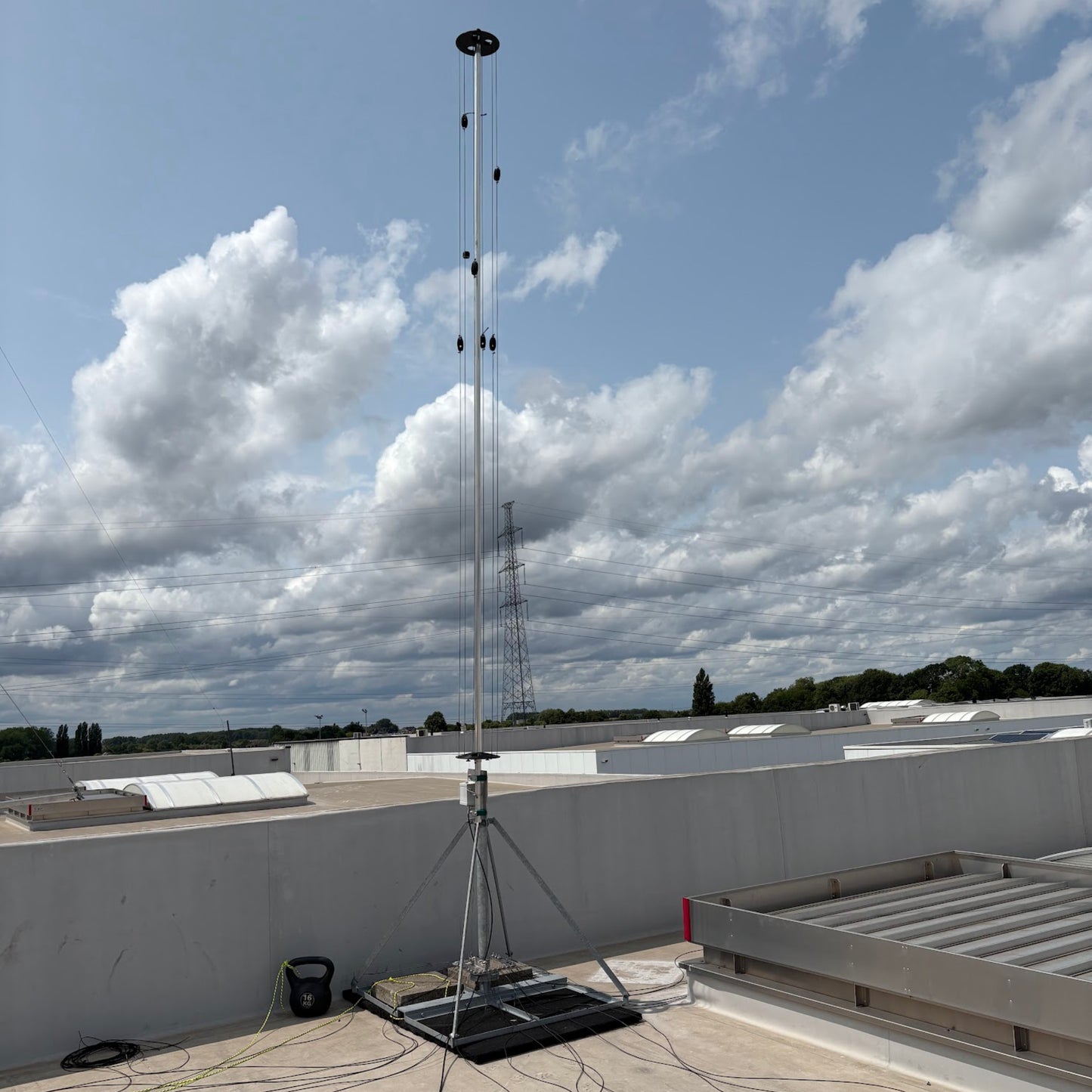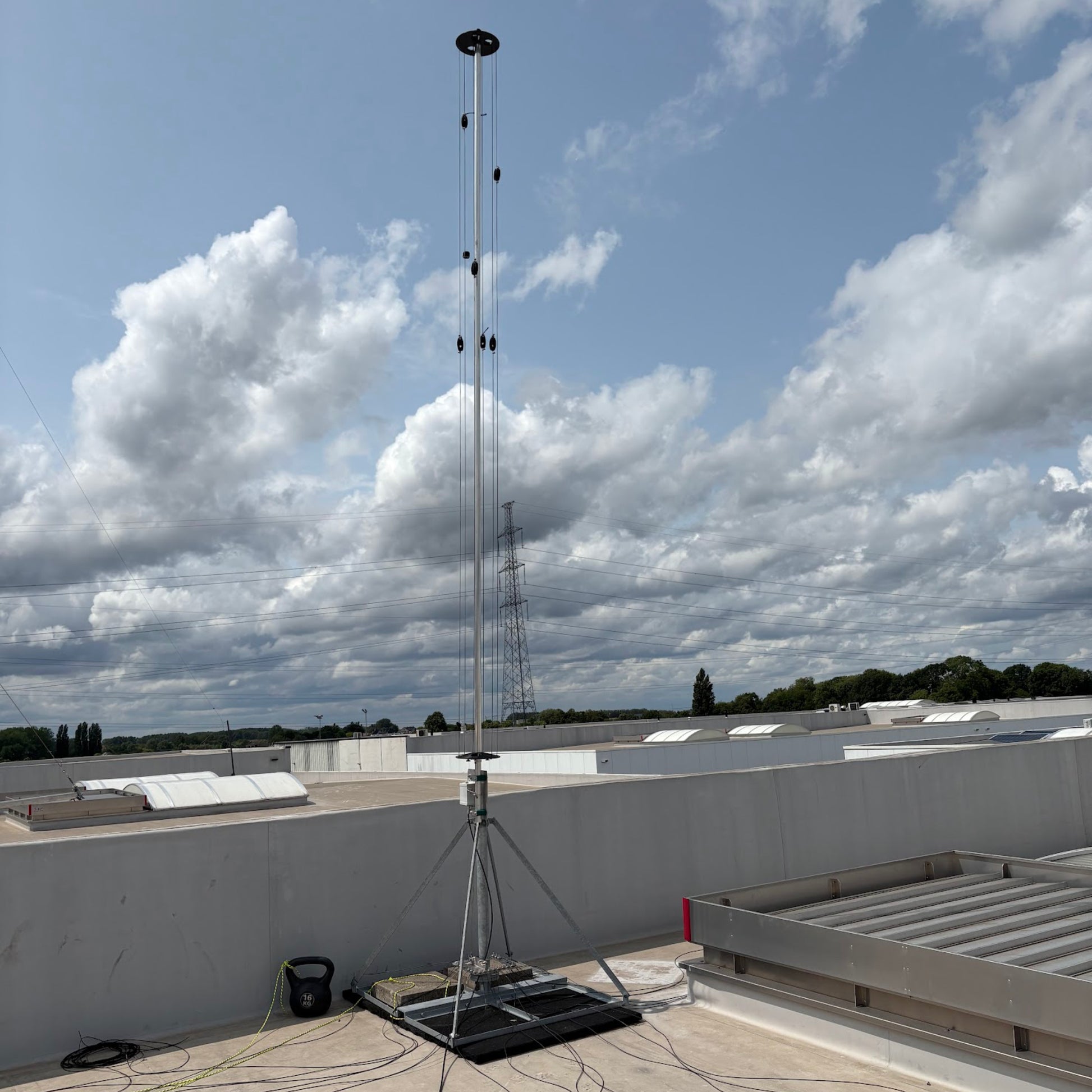RF Guru
6kW VertX 20M-6M
6kW VertX 20M-6M
Couldn't load pickup availability
VertX is a smarter multiband fan vertical engineered for low loss, clean feedline behavior, and consistent low-angle DX. The feedpoint is raised ~1.1 m above the radial field, the 20 m radiator is a full quarter-wave starting at that feedpoint, and the higher-band fan wires start ~20 cm above the main radiator to align with the high-current zone. The result: less ground coupling loss, stronger low-angle radiation, and predictable tuning across 20–6 m.
Specs at a Glance
| Bands | 20 m, 17 m, 15 m, 12 m, 10 m, 6 m |
| Power | 6 kW ICAS / 3 kW PEP / 1.5 kW FT8/FT4 |
| Feedpoint | 50 Ω with integrated high-power common-mode choke |
| Feedpoint Height | ~1.1 m above radial plane |
| Main Radiator | 35 mm aluminum pole, full ¼-wave for 20 m |
| Fan Elements | Mounted on 2 × ASA plates; higher-band wires start ~20 cm above the 20 m element |
| 10 m Coverage | Three dedicated elements for robust efficiency and bandwidth |
| Radial Plate | Optional — supports RF.Guru radial kits |
| Materials | Marine-grade aluminum (radiator), ASA (fan plates), RVS INOX 316 (mount), stainless hardware |
What’s Included
- VertX modular aluminum radiator (20–6 m fan configuration)
- Integrated high-power common-mode choke at the feedpoint (factory installed)
- RVS INOX 316 stainless mounting plate
- 3 × ASA plates for fan element mounting
- Protective cap for the aluminum pole
- Stainless hardware kit
- Optional: Radial plate + radial kit (see below)
- Optional: Heavy-Duty Ballast Frame for 50×50 cm tiles with Ø60.3 mm pole (1.1 m)
Radial Kits
The radial plate is optional. Choose a kit that matches your footprint and efficiency goals. For ground-mounted systems, radial count matters more than exact resonance:
- Good: 16 × 5 m radials — compact, effective baseline.
- Better: 24 × mixed lengths (8 × 5.3 m, 8 × 3.6 m, 8 × 2.7 m) — lower ground loss and smoother band balance.
- Best: 32 × mixed radials (e.g., 10 × 5.3 m, 12 × 3.6 m, 10 × 2.7 m) spread evenly over 360° — near-solid RF ground and maximum efficiency on all bands.
Why This Geometry Works
- Raised feedpoint: ~1.1 m above the radial plane reduces near-soil coupling and favors low angles.
- Center element: 35 mm aluminum pole ensures rigidity and high current handling.
- Fan support: Two ASA plates keep higher-band wires aligned in the high-current zone.
- 10 m optimization: Three dedicated elements deliver wide bandwidth and stable efficiency.
- No loading tricks: Pure quarter-wave elements; no lossy linear loading or folded compromises.
Quick Comparison — VertX vs Typical Fan Verticals
| Aspect | VertX | Typical Fan Vertical |
|---|---|---|
| Feedpoint placement | Raised ~1.1 m, less ground loss, better low-angle DX | At base; higher ground coupling |
| Main radiator | 35 mm aluminum pole, full ¼-wave for 20 m | Often starts at ground, smaller diameters |
| Fan element support | 2 × ASA plates for precise spacing & alignment | Simple clamps, less precision |
| 10 m coverage | Three dedicated elements, wide bandwidth & efficiency | Single short wire, narrow bandwidth |
| Feedline behavior | Integrated high-power choke at feedpoint | External or undersized choke needed |
Operating Bands & Modes
- 20 m: Full ¼-wave radiator provides stable, efficient low-angle DX.
- 17 m & 15 m: Fan wires aligned at current maxima ensure balanced, efficient radiation patterns.
- 12 m: Clean, low-angle DX capability with a proper radial field.
- 10 m: Three dedicated elements deliver broad bandwidth and strong radiation efficiency — ideal for contesting.
- 6 m: Low SWR and efficient pattern; excellent for sporadic-E and competitive operation.
As a true vertical, VertX favors low-angle DX across all supported bands. It is not intended for NVIS use.
Radiation Angles per Band
| Band | Radiation Character | Typical Takeoff Angle* |
|---|---|---|
| 20 m | Full ¼-wave radiator, stable DX | ~18–22° |
| 17 m | Fan element, efficient coupling | ~16–20° |
| 15 m | Fan element, low-loss pattern | ~14–18° |
| 12 m | Balanced low-angle DX | ~12–16° |
| 10 m | Three dedicated elements, wide bandwidth | ~10–14° |
| 6 m | Efficient pattern, strong for Es and DX | ~8–12° |
*Angles modeled at 6–10 m mounting height with a proper radial field in average ground. Real-world values vary with soil, surroundings, and installation.
Installation Notes
- Height: 6–10 m AGL in the clear is ideal for low-angle DX.
- Radials on ground: Select one of the kits above; for ground-mounted systems, more radials beats resonant cutting.
- Elevated radials: If raised (~0.05–0.1 λ), 2–4 tuned per band can replace the ground mat.
- Optional ballast frame: Freestanding mounting when no fixed mast is available (50×50 cm tiles, Ø60.3 mm pole, 1.1 m).
For all bolts, screws, and electrical interfaces, apply AL-1100 aluminum paste during assembly to prevent galvanic corrosion and keep contact resistance low in outdoor exposure.
How often? One thorough application at installation is typically sufficient. In harsh coastal or polluted environments, reapply every 2–3 years during a visual inspection, or sooner if you open/retorque joints.
Electrical Specifications
- Bands: 20 m, 17 m, 15 m, 12 m, 10 m, 6 m (fan vertical)
- Power Rating: 6 kW ICAS / 3 kW PEP / 1.5 kW FT8/FT4 (integrated high-power choke)
- Feedpoint: 50 Ω; feedpoint located ~1.1 m above radial plane
- Typical SWR: Low SWR on 6 m; tuner-friendly across HF bands (installation dependent)
Mechanical Characteristics
- Radiator: 35 mm marine-grade aluminum, modular sections
- Base Hardware: RVS INOX 316 stainless mounting plate
- Fan Plates: 2 × ASA for precise spacing and element support
- Fasteners: Stainless steel throughout
- Weather Protection: Protective pole cap; outdoor-rated fittings
Optional Accessories
- Radial Plate: Optional plate to simplify kit attachment and strain relief
- High-power feedline isolation: 9 kW Wide Band HF High Power +30 dB CMR Line Isolator (1.5–30 MHz) for multi-antenna or harsh RFI sites
- Heavy-Duty Ballast Frame: 50×50 cm tiles, Ø60.3 mm pole, 1.1 m
Notes on SWR & Real-World Installs
Performance depends on radial system, height, soil, feedline routing, and nearby structures. Measure SWR after installation and adjust height/radials for best results.
Mini-FAQ
- Is NVIS supported? — No. VertX is a low-angle vertical optimized for DX.
- Do I need an external choke? — Not normally. VertX includes a high-power integrated choke; add a line isolator only in difficult RFI layouts.
- What mast does it fit? — The base plate fits a Ø60.3 mm pole (typical steel/aluminum masts).
- What maintenance is needed? — Use AL-1100 aluminum paste during assembly; re-check fasteners every few years or after severe weather.
Share

